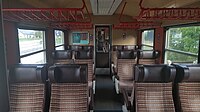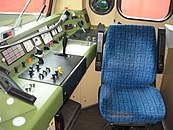ÖBB 5047
| ÖBB / StB / GySEV 5047 neg T4 |
|
|---|---|
|
5047 045-9 and 5047 044-2 Hermagor (KTN)
|
|
| Numbering: | ÖBB: 5047 001-100 StB: VT51–52 or 5047 401–402 |
| Manufacturer: | Jenbacher works |
| Year of construction (s): | 1987-1995 |
| Axis formula : | 2 B' |
| Genre : | Diesel railcars |
| Gauge : | 1435 mm ( standard gauge ) |
| Length over buffers: | 25,420 mm |
| Service mass: | 43.7 t |
| Top speed: | 120 km / h |
| Continuous output : | 419 kW |
| Impeller diameter: | 840 mm |
| Motor type: | MTU 12V183TC12 |
| Power transmission: | hydraulic |
| Number of traction motors: | 1 |
| Drive: | diesel-hydraulic |
| Type of speed switch: | 7 speed levels |
| Brake: | Hydrodynamic brake, Ep brake, Mg brake |
| Train control : | PZB |
| Coupling type: | Turbo transmission |
| Seats: | 62 |
The locomotives of the series 5047 are branch line - diesel railcars of ÖBB .
history
In 1983, the ÖBB awarded an order for six new diesel multiple units based on the German 627 series to Jenbacher Werke . The first vehicle was completed in July 1987 and presented on an international press trip to Rosenburg am Kamp . After successful use on the routes of the " Schweinbarther Kreuz" in the Lower Austrian Weinviertel , where the six 5047 were used in a quickly conceived "special plan", a total of 100 railcars with modified march walkers of the 5047 series and five sets (10 individual vehicles) of the Series 5147 built. The Solo-5047 cost ATS 27 million at the time, a control car would hardly have been cheaper at ATS 22 million. Therefore, the solution for the 5147 as a double multiple unit in the form of two closely coupled vehicles came into play; Control cars for 5047 were not procured, but there were operations with bicycle car 7147 converted from rail bus sidecar 7081 .
These two vehicle types replaced the old series 5044 , 5144 , 5145 , 5146 and 5081 , some of which were from the interwar period, technically obsolete and had reached the end of their economic useful life. In contrast to locomotive-hauled trains, the railcars can be operated in one-man operation without a train attendant (ÖBB designation "0: 0") and thus personnel costs can be reduced, since the driver can also sell tickets. Later all vehicles were equipped with ticket vending machines, which today makes ticket sales by the driver obsolete. With the use of these vehicles, the ÖBB was able to achieve an improvement in the economic result on numerous branch lines.
The shape and color of the series was developed by Wolfgang Valousek . The railcars 5047 001 to 032 were painted at the factory in ivory, ultramarine blue and blood orange, 033 to 100 in agate gray, ultramarine blue and traffic red.
The vehicles 003-009, 011, 012, 014, 018 and 019 were modernized from 2004: They got new paintwork in the current ÖBB colors for local traffic ( oblique design in red / gray, parts of the front in dark gray), and in the interior the seats re-upholstered (in blue) and the partitions removed.
The success of the railcars also prompted the two Austrian private railways Steiermärkische Landesbahnen (today Steiermarkbahn and Bus GmbH ) and Raab-Ödenburg-Ebenfurter Eisenbahn (today GYSEV Raaberbahn AG ) to each purchase two vehicles of this series, which were approved according to ÖBB rules. To "compensate for kilometers" for the use of ÖBB vehicles on private railways, these railcars are also used on ÖBB routes. In contrast to the ÖBB railcars, the private rail vehicles have roller displays on the fronts.
In addition, the NVAG (today the North German Railway Company Niebüll ) procured a railcar that is in use on the Niebüll - Dagebüll route . This one has a different interior with first and second class.
The seven vehicles 008, 020, 031, 044, 062, 068 and 100 were sold to Raaberbahn AG (GYSEV) in 2011 and classified as 247 503-509.
After 2005 the 5047 was replaced on some routes by the 5022 series .
With the 5047 074, which had an accident with a truck on the Almtalbahn in summer 2016, the first 5047 was dismantled between October 8 and 11, 2017. 5047 017, which collided with an unrolled freight train on the Erlauftalbahn in October 2016 and was badly damaged, was collected as the second vehicle in the series. In April 2019 the 5047 095 collided with a truck on the Marchegger Ostbahn and subsequently the 5047 057 collided with a tractor-trailer in Gänserndorf on September 30, 2019, and then burned out.
commitment
The railcars were used in the entire non-electrified route network of the ÖBB, but were replaced by these on some routes after the 5022 series was acquired . Currently (2020) they are used on the non-electrified routes in the eastern region with the exception of the outer Aspangbahn , on the Wiener Neustadt – Sopron railway they also come to Hungary . They also run in Upper Austria on the Mühlkreisbahn , Innkreisbahn , Hausruckbahn and Almtalbahn .
Identical railcars are used by the following private railways:
Picture gallery
Stop request button for required stops
5047 061-6 with 170 years of Sparkasse Oberösterreich painting in Braunau am Inn
ÖBB 5047 001 in ivory / ultramarine blue / blood orange with old logo
5047 402 of the Steiermarkbahn und Bus GmbH as VT 52
5047 501 of the Raaberbahn
neg T4 in Dagebüll Mole
literature
- Günter Kettler: Diesel railcar of the ÖBB, Verlag bahnmedien.at, Vienna 2011, ISBN 978-3-9502648-7-6
- Markus Inderst : Picture atlas of the ÖBB locomotives. All traction vehicles of the Austrian Federal Railways. GeraMond, Munich 2010, ISBN 978-3-7654-7084-4 .
- Werner Prokop: 30 years of ÖBB series 5047, "savior of the branch lines" - a portrait of a family of railcars . Railway-Media-Group, Vienna 2017, ISBN 978-3-902894-56-4 .
Individual evidence
- ↑ Three seriously injured after a collision between train and truck
- ↑ Gänserndorf - railcar burned after collision with truck
- ↑ The new ÖBB schedule , Eisenbahn Österreich 2/2020, page 65











